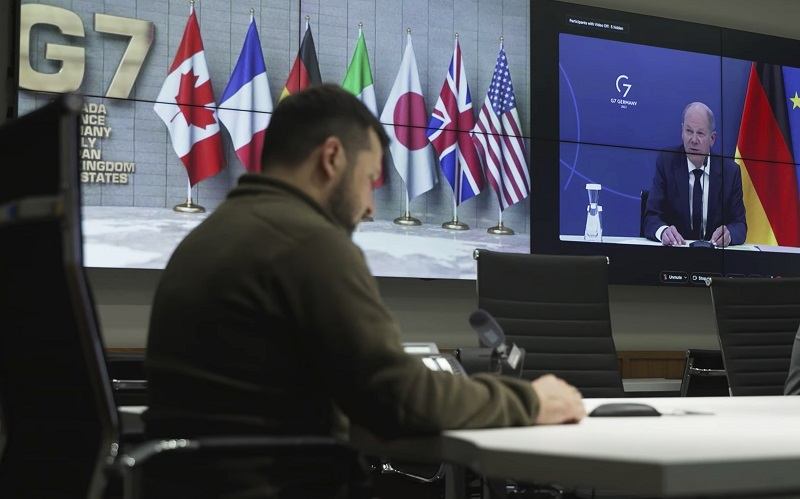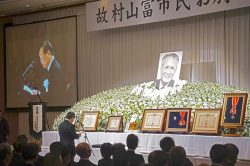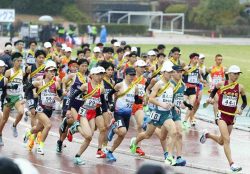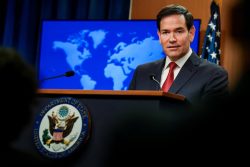
In this image from video provided by the Ukrainian Presidential Press Office, Ukrainian President Volodymyr Zelenskyy, left, and German Chancellor Olaf Scholz, right on the screen, attend the video conference of the leaders of the Group of Seven and Ukraine, in Kyiv, Ukraine, Tuesday, Oct. 11, 2022.
15:49 JST, October 12, 2022
The Group of Seven nations on Tuesday committed themselves to continue supplying Ukraine’s “urgent requirements” for military equipment and demanded that Russia “completely and unconditionally withdraw all of its troops and military equipment from Ukraine,” including Crimea and all “annexed” regions.
In a speech to the meeting, held via video among the leaders of the United States, Canada, Japan and major European allies, Ukrainian President Volodymyr Zelensky detailed a second straight day of Russian bombardment of civilian areas, far from the front lines of the war. Tuesday brought dozens of armed drones, “plus 28 launches of Russian missiles,” he told them. “And that’s just for this morning.”
Later, in his regular evening address to Ukrainians, Zelensky said that 20 Russian missiles, and “most” of 15 attack drones, had been shot down. Citizens were working “quickly and efficiently” to repair Monday’s damage, he said, and “if it weren’t for today’s strikes, we would have already restored the power supply, water supply and communication that the terrorists damaged yesterday.”
Zelensky repeatedly appealed to the G-7 for a more comprehensive “air shield” for Ukraine. “When Ukraine receives a large number of modern and effective air defense systems, the key element of Russian terror – missile strikes – will cease to work,” he told them. Russia, he said, was already losing the war, but President Vladimir Putin, “who is now in the final stages of his reign, still has room for further escalation.”
Monday’s massive attack sent residents in peaceful urban areas running for shelters, as administrative buildings and residences were destroyed. The strikes caused widespread outrage, as well as increased optimism in the Biden administration that heretofore fence-sitting countries would join in condemning Russia in a vote scheduled for later this week in the United Nations General Assembly.
Both the United States and Russia have been heavily lobbying among the U.N.’s 193 member nations, 35 of which abstained the last time the assembly voted on a condemnation resolution, just 10 days after Russia’s initial invasion of Ukraine in February. The vote is nonbinding but is seen by its U.S. sponsor and Western allies as an important test of global rejection of Russia.
China and India, whose leaders have publicly taken issue with Moscow’s actions, will be carefully watched – although there is little indication that either will take a firm stand. So will countries such as the United Arab Emirates, which has vacillated between approving and abstaining during previous votes condemning Russia.
U.A.E. President Mohamed bin Zayed al-Nahyan visited Moscow on Tuesday, where Putin told him that his country could play a “significant” role in efforts to reach a solution in Ukraine. Mohamed, considered a close defense partner of the United States, later posted to Twitter photos of himself with Putin, along with a message saying they had “discussed several issues of mutual concern, including the Ukraine crisis, and the importance of engaging in dialogue to reduce tensions and arrive at a diplomatic solution.”
At an international meeting last week, Valentina Matviyenko, speaker of Russia’s Federation Council, or upper house, called for talks between the Russian and Ukrainian parliaments in a theatrical show of Russia’s willingness to discuss peace. But the proposal had little credibility, coming after Putin’s demand that Ukraine accept Moscow’s illegal annexation of the Ukrainian territories of Crimea (in 2014) and now Zaporizhzhia, Donetsk, Luhansk and Kherson.
Ukraine maintains that there is no point in dialogue or negotiations until Russia ends the war and withdraws its troops from all areas within Ukraine’s internationally recognized territorial boundaries. “We must admit the obvious fact,” Zelensky said to the G-7 leaders. “There can be no dialogue with this leader of Russia, who has no future. He himself rejected the dialogue.”
In a communique after their meeting, the G-7 leaders welcomed Zelensky’s “readiness for a just peace,” which they said included the complete restoration of Ukraine’s territorial integrity; safeguarding its future ability to defend itself; ensuring its recovery and reconstruction, including using Russian funds; and pursuing accountability for Russian war crimes.
After his meeting with Mohamed, Putin hosted Rafael Grossi, director general of the International Atomic Energy Agency. Grossi, who met last week with Zelensky and expects to return to Ukraine, has been engaged in intense efforts to establish a protection zone around the Russian-occupied Zaporizhzhia nuclear power plant. The immediate vicinity of the reactors has been shelled in the past several months, with both sides blaming the other.
Putin, who has threatened to use nuclear weapons in Ukraine as his forces have lost ground, criticized “elements of excessive dangerous politicization of everything to do with nuclear activity” during his meeting with Grossi, according to Russia’s Interfax news agency. He said “it will be our pleasure to discuss all our issues of mutual interest, and perhaps concern,” including the Zaporizhzhia facility.
Meanwhile, Energoatom, the Ukrainian energy agency, on Tuesday accused Russia of kidnapping a second senior official from the plant, which is being operated by Ukrainian staff while under Russian control. “They keep holding him at an unknown location and [are] probably using methods of torture and intimidation,” the agency said on its Telegram channel. Late last month, the Russians detained and then released the Ukrainian director of the facility.
Much of the G-7 discussion, held privately among leaders following Zelensky’s address, concerned Ukraine’s “urgent” request for air defense systems. But the leaders pledged their continued support to Ukraine rather than any significant expansion of it, said an official with direct knowledge of the conversation, who spoke on the condition of anonymity about the closed-door meeting.
President Biden, the official said, “emphasized the importance” of the systems, but there was little indication that the United States was prepared to move beyond commitments it has already made to furnish them.
The administration is “working hard” to deliver to Ukraine the first two units of a promised midrange air defense system, the NASAMS, National Security Council coordinator John Kirby told reporters in Washington. Defense officials have said the system is scheduled for delivery between now and December. An additional six units are also destined for Ukraine, but manufacturing them is likely to take a year or more.
Kirby noted that Ukraine already has elements of a “layered air defense” in its arsenal, including short-range Stingers sent early in the conflict and longer-range, Russian-made S-300 systems from the Soviet era. Ukraine has said it shot down about half of approximately 80 missiles Russia fired at cities far from the front lines Monday, most of them air-launched cruise missiles.
“There is no one silver-bullet weapons system that is best used against cruise missiles,” Kirby said, adding that variables include how soon after launch they are detected and their flight path. “There’s not one system that somehow is going to solve that problem.
“I’m not going to get ahead of where we are in the decision process” of what weapons to send, and when, he added. “We have provided air defense systems to Ukraine, and we plan to continue. When there is something to announce in that regard . . . we will do that.”
In Germany, Der Spiegel magazine said the first of four German IRIS-T vehicle-mounted air defense systems had arrived in Ukraine, a day after Defense Minister Christine Lambrecht said that shipment of the long-promised systems was being accelerated.
In Brussels, where a gathering of the Ukraine “contact group” of more than 40 nations contributing supplies to Ukraine is scheduled this week, along with a meeting of NATO defense ministers, NATO Secretary General Jens Stoltenberg told reporters that they would discuss how to “ramp up production” of defense equipment, both to send it to Ukraine and to replenish their own stocks. The German systems, he said, were “something that Germany was expecting to order for itself.”
“I expect ministers to make decisions . . . on how to use the NATO planning process” to agree on production targets and provide industry with long-term orders, he said.
Energy prices were also a major theme of the G-7 discussions, with leaders saying that while there had been good progress on cutting energy use, “there was concern on prices and a broad agreement that more needs to be done through mechanisms like oil and gas price caps,” the official with direct knowledge of the talks said. Biden, the official said, spoke about the United States’ willingness to support the energy market with liquefied natural-gas deliveries and expressed concern about announced production cuts by the OPEC Plus cartel, of which both Russia and Saudi Arabia are members.
Kirby later told reporters that the administration was “reviewing” the U.S. relationship with Saudi Arabia.
"News Services" POPULAR ARTICLE
-

American Playwright Jeremy O. Harris Arrested in Japan on Alleged Drug Smuggling
-

Japan’s Nikkei Stock Average as JGB Yields, Yen Rise on Rate-Hike Bets
-

Japan’s Nikkei Stock Average Licks Wounds after Selloff Sparked by BOJ Hike Bets (UPDATE 1)
-

Japan’s Nikkei Stock Average Buoyed by Stable Yen; SoftBank’s Slide Caps Gains (UPDATE 1)
-

Japanese Bond Yields Zoom, Stocks Slide as Rate Hike Looms
JN ACCESS RANKING
-

Keidanren Chairman Yoshinobu Tsutsui Visits Kashiwazaki-Kariwa Nuclear Power Plant; Inspects New Emergency Safety System
-

Imports of Rare Earths from China Facing Delays, May Be Caused by Deterioration of Japan-China Relations
-

University of Tokyo Professor Discusses Japanese Economic Security in Interview Ahead of Forum
-

Tokyo Economic Security Forum to Hold Inaugural Meeting Amid Tense Global Environment
-

Japan Pulls out of Vietnam Nuclear Project, Complicating Hanoi’s Power Plans





















